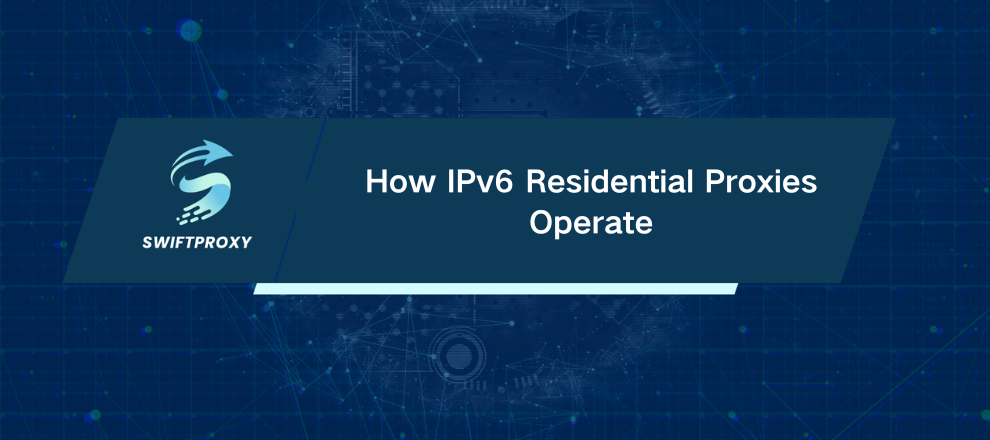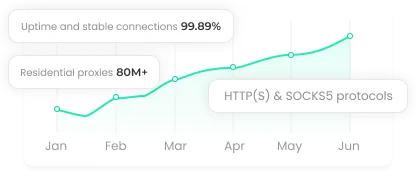How IPv6 Residential Proxies Operate
Imagine surfing the web from anywhere in the world without ever getting blocked. Sounds like a superpower? That’s exactly what IPv6 residential proxies make possible. Whether it’s monitoring SEO, managing multiple social media accounts, or scraping web data at scale, these proxies give you a stealthy edge online. Built on Internet Protocol Version 6, IPv6 residential proxies let users bypass geo-restrictions, avoid CAPTCHAs, and dramatically reduce the risk of bans. Unlike datacenter proxies that rely on generic cloud servers, these proxies tap into real devices. That makes them smarter, more reliable, and far harder for websites to flag.

Understanding IPv6 Residential Proxies
IPv6 residential proxies use genuine IP addresses provided by Internet Service Providers to real devices—computers, smartphones, and laptops. In practical terms, this means that anyone using an IPv6 residential proxy looks just like an ordinary internet user.
The core goal here is simple: speed, performance, efficiency, and security. Because these proxies come from real users' devices, websites treat them as authentic traffic. The result? Fewer blocks, fewer CAPTCHAs, and a smoother online experience.
The Differences Between IPv6 Residential Proxies and Datacenter Proxies
Residential IPv6 proxies and datacenter proxies might both serve as gateways to the web—but they play very different roles.
IP Sourcing: Residential proxies use IPs from ISPs, whereas datacenter proxies pull from cloud hosting providers.
Detection: Residential proxies are far less likely to get flagged because they appear as real users. Datacenter IPs are easier to detect, which can trigger blocks.
Use Cases: Residential proxies excel in tasks requiring stealth, like geo-restricted content access or high-volume web scraping. Datacenter proxies are often used for automated or bot-driven tasks.
Why Residential IPs Are Difficult to Detect
The secret lies in authenticity. Residential IPs originate from real devices in real homes. When you connect through one, websites see a legitimate user, not a proxy. That's why businesses rely on residential IPv6 proxies for scraping data, monitoring SEO, managing multiple social accounts, and verifying ads—all without raising red flags.
How IPv6 Residential Proxies Function
At their core, proxies are middlemen. They take your requests, pass them to the web, and then deliver the responses back—hiding your real IP along the way. IPv6 residential proxies do this via residential devices, with IP addresses assigned by ISPs.
Many providers use backconnect proxies, meaning you connect to one endpoint and rotate multiple residential IPv6 addresses behind it. Each port can correspond to a unique IP, letting you switch locations effortlessly.
Here's the process in action:
You send a request to a website.
The proxy routes it through a residential device.
The website sees the IPv6 residential IP instead of yours.
The response is sent back through the proxy to you.
The Power of IPv6
IPv6 addresses are 128-bit, creating an almost infinite pool—over 340 undecillion unique IPs. That's a staggering leap from IPv4's 4 billion addresses. With such vast resources, proxies can rotate IPs endlessly, letting you handle high-volume tasks without triggering bans.
Dual Stack Support and Translation Mechanisms
Even though IPv6 is the future, some websites still rely on IPv4. Dual-stack support handles both IP versions, often using NAT (Network Address Translation) to bridge them. Tools like NAT64 and DNS64 ensure seamless communication between IPv6 devices and IPv4 servers.
Advantages and Use Cases
IPv6 residential proxies deliver tangible advantages:
Faster speeds and higher uptime thanks to residential routing.
Broader IP availability for global access.
Improved anonymity for web scraping, ad verification, and SEO monitoring.
Bypass geo-restrictions and IP bans to access worldwide content freely.
Marketing agencies, developers, and brands use these proxies to collect accurate data, monitor campaigns across regions, and manage multiple accounts—all without risking detection.
Current Challenges
Despite its advantages, IPv6 adoption is limited. Many providers focus on IPv4, leaving IPv6 infrastructure underdeveloped. Legacy websites still favor IPv4, creating compatibility issues. And while IPv6 offers huge IP pools, some websites can block entire subnets, which demands smart rotation strategies to maintain access.
The Bottom Line
IPv6 residential proxies combine speed, reliability, and authenticity to give professionals a clear advantage online. With vast IP pools, stealthy routing, and dual-stack support, they make high-volume web tasks safer and more efficient than ever. The future of web access is here, and IPv6 residential proxies put you in control.

















































